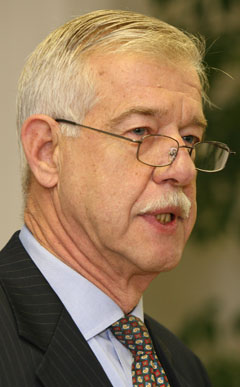Sveiks svētkos! Šajā mūsu valsts 93. gadskārtā visiem domas atgriežas pie Latvijas, pie tās Latvijas, kādu to atceramies, pie tās, par kādu cerējām, vai pie tās, kāda tā šodien ir. Katrs no mums izvēlēsies to Latviju, kādu gribēs pieminēt.
Tie, kas domās par Latviju, kāda viņa kādreiz bija, būs vīlušies. Tie, kas domās par to Latviju, par kuru viņi cerēja, arī būs vīlušies. Bet tie kas saprot, ka Latvija ir tāda, kāda viņa ir, jo dzīvo citos laikos un citos apstākļos, sapratīs, ka arī šodienas Latvija ir tikpat īsta, tikpat cerīga un tikpat nozīmīga mums visiem, kā visas pārejās Latvijas, ko savā prātā un izdomā esam radījuši.
Mēs visi apzināmies, ka tā Latvija, kas šodien pastāv, ir vienīgā īstā, un tāpēc mūsu attieksmei ir jābūt pamatotai šodienas īstenībā. Šī šodienas īstenība ir tas apstāklis, kam jānosaka mūsu attieksme pret savu tēvuzemi vai, kā arvien biežāk noticis, – ar mūsu vectēvu tēvzemi.
Ja vien vēlēsimies, varēsim atrast daudz ko, kas mūs Latvijā neapmierina, daudz ko, kas mums ir nepieņemams, un daudz ko tādu, kam pēc divdesmit neatkarības atgūtiem gadiem vairs nevajadzētu pastāvēt. Liekas, ka neskatoties uz daudzu dažādu partiju centieniem, valsts vēl ir stipri nesakārtota, saimnieciski neatplaukusi un no savtīgiem, dažreiz negodīgiem cilvēkiem vadīta.
Nesenajā Pasaules latviešu zinātnieku 3. kongresa atkāšanas runā bijusī Valsts prezidente Vaira Vīķe-Freiberga nobeidza savu pārskatu par Latviju un Latvijas zinātni ar vārdiem: “Kas vainas šai tautai, kas vainas mums, ka divdesmit gados nespējam savu valsti sakārtot?”
Atbildi viņai nespēja dot neviens, bet pesimisms arī nav Latvijas problēmu atrisinājums. Ir apstākļi un rādītāji, kas tomēr liek mums cerēt, ka lēnām, bet noteikti Latvija tomēr atveseļojas, tomēr sāk iet par pareizo ceļu, un ka optimisti galu galā teiks pēdējo vārdu.
Nupat redzējām, kā Grieķija burtiski sabrūk zem savas parādu nastas, ko nespēj atmaksāt. Latvija ir spējīga savus parādus atmaksāt. Tāpat nesen Italija atzinās, ka viņas parādi ir lielāki, nekā visas valsts iekšējais kopprodukts. Mēs dzirdam, ka Spānija, varbūt Portugāle un Īrija būs nākošās, kas atzīs savas tautsaimniecības sabrukumu. Tepat Amerikas Savienotajās Valstīs mēs katru dienu redzam, ka valsts ir paralizēta abu lielo partiju ideoloģisko cīņu rezultātā.
Latvija ir zaudējusi nu jau divsimt tūkstošus iedzīvotāju par labu emigrācijai, un liekas, ka drīz tā būs no strādājošiem tukša, bet vienlaikus Ukraina ir zaudējusi sešus miljonus iedzīvotāju, un Igaunijā parādās bažas par to, vai tur vēl dzīvo viens miljons iedzīvotaju. Ja bezdarbs Latvijā ir nedaudz virs desmit procentiem, tad Spānijā tas ir divreiz tik liels.
Pasaule ir pilna problēmām, kas liekas neatrisināmas, un, dabiski, Latvija arī no tām cieš. Tomēr Latvijā esam iztikuši bez vardarbības, bez sabiedriskām nekārtībām. Valdība tika sastādīta un tā strādā pie budžeta pieņemšanas ar visiem šī procesa sāpīgajiem iznākumiem.
Neaicinu nevienu domāt, ka Latvija ir vislabāk sakārtotā valsts pasaulē, bet aicinu nenodoties pārmērīgam pesimismam, jo šī mūsu Latvija vēl tikai aug un veidojas. Tur aug jauna paaudze ar jaunu pieeju un citu savstarpējo attiecību kultūru. Tur tautsaimniecība sāk atkopties un tur lietas mainīsies. Mūsu devums var būt ticība, palīdzība un sadarbība, veicot valsts sakārtošanas darbu. Piedalīsimies, ne tikai ar kritiku, bet ar radošu un palīdzīgu roku, lai Latvija spētu pabeigt savu valstiskuma atjaunošanas darbu. Cerēsim un ticēsim, ka Latvijas 93. gads būs daudz labāks, nekā bija iepriekšējais. Dievs, svētī Latviju!

Ints Rupners ir Pasaules brīvo latviešu apvienības valdes priekšsēdis. (Foto: PBLA)



